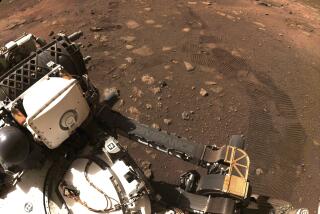Health Hazards Pose Challenges on Mars Mission
On July 16, 1969, three American astronauts set out on a 165-hour, 18-minute mission that remains the highlight of the U.S. space program: the first landing on the moon.
Now, the National Aeronautics and Space Administration is planning a voyage in the year 2005 to the red planet, Mars, a 35-million mile trip that will make the moon mission look like a drive to the corner market.
âWhat we want to know is if we can send human beings to Mars and bring them back safely,â said biochemist Paul Rambaut of the National Institutes of Health in Bethesda, Md.
Team of Scientists
Rambaut is working with a team of NASA scientists who are trying to determine the health hazards of a space mission unlike any other ever undertaken.
For Apollo 11 astronauts Neil Armstrong, Michael Collins and Edwin Aldrin, it took four days from blastoff to lunar landing.
But for the crew that will journey to Mars, the round trip will take several months and may be fraught with such maladies as loss of bone mass, immune system depression, vertigo, claustrophobia and possibly heart and blood vessel damage.
âWe know this because of studies of both U.S. astronauts and Soviet Salyut cosmonauts,â Rambaut told a recent meeting of scientists and engineers at a conference sponsored by the American Institute of Aeronautics and Astronautics in Los Angeles.
âWe want to verify now what those changes in the immune system will be and make sure that theyâre not related to weightlessness itself,â he said.
Some of the tests for such health hazards are being conducted in special zero-gravity chambers and under water to enable scientists to study the long-term physiological effects of weightlessness.
Once on the Martian surface, the crew will again encounter the effects of gravity, but the force on Mars is relatively weak.
Rambaut said it has been known for many years that bone mass is lost even during the most brief missions in space and that some of those skeletal changes can be counteracted with exercise.
Mostly Irreversible
But for the most part, he said, loss of bone mass is irreversible.
Another major problem confronting a crew on the Martian surface is exposure to solar flares, the shower of highly charged radioactive atoms from the sun.
Mars, unlike Earth, does not have a protective shield of gases around it to deflect harmful radioactivity, so scientists will have to use ingenuity to provide a makeshift shield 35 million miles from home.
âThere are some attempts to develop a solar flare warning system and (to reduce) the danger with solar aluminum,â he said. âBut weâre also trying to assess the effectiveness of anti-radiation drugs.
Development of safe anti-radiation drugs could prevent development of such devastating illnesses as leukemia and aplastic anemia, two disorders that can occur as a result of exposure to excessive amounts of radiation.
The problem, however, is that such drugs may respond somewhat differently in space than they do when taken on Earth, a problem that Rambaut said will require several years of study if such medications eventually will be used to prevent the ill-effects of exposure to radiation.
He said scientists are already aware that a solar flare on Mars can generate more than 20 times the amount of radiation that is deemed safe for human exposure in one year.
A Few Days on Mars
Rambaut said that even though some scientists across the country would like to see an international group of astronauts travel to the Red Planet, he said NASA probably will send a group of six American astronauts for a few days to the red planet. The bulk of the trip will be consumed by travel time, he said.
Rambaut noted that Mars, with its deep canals and icy polar caps, is a landscape of frozen valleys and a distinctive red color caused by iron oxidation eons ago, the process that colored the planet red.
He said even though Mars is the most studied of all of the terrestrial planets, its high winds, bone-chilling cold and vulnerability to massive blasts of radiation pose several problems for scientists who are trying to anticipate possible health hazards of a Mars mission prior to blastoff in 18 years.
More to Read
Sign up for Essential California
The most important California stories and recommendations in your inbox every morning.
You may occasionally receive promotional content from the Los Angeles Times.










